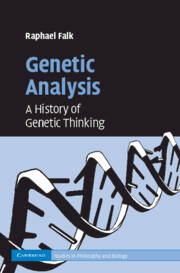Book contents
- Frontmatter
- Contents
- List of figures
- Acknowledgments
- Introduction
- PART I FROM REPRODUCTION AND GENERATION TO HEREDITY
- 1 The biologization of inheritance
- 2 Mendel: the design of an experiment
- PART II FAKTOREN IN SEARCH OF MEANING
- PART III THE CHROMOSOME THEORY OF INHERITANCE
- PART IV GENES AS THE ATOMS OF HEREDITY
- PART V INCREASING RESOLVING POWER
- PART VI DEDUCING GENES FROM TRAITS, INDUCING TRAITS FROM GENES
- PART VII WHAT IS TRUE FOR E. COLI IS NOT TRUE FOR THE ELEPHANT
- Concluding comments
- Bibliography
- Index
2 - Mendel: the design of an experiment
Published online by Cambridge University Press: 07 August 2009
- Frontmatter
- Contents
- List of figures
- Acknowledgments
- Introduction
- PART I FROM REPRODUCTION AND GENERATION TO HEREDITY
- 1 The biologization of inheritance
- 2 Mendel: the design of an experiment
- PART II FAKTOREN IN SEARCH OF MEANING
- PART III THE CHROMOSOME THEORY OF INHERITANCE
- PART IV GENES AS THE ATOMS OF HEREDITY
- PART V INCREASING RESOLVING POWER
- PART VI DEDUCING GENES FROM TRAITS, INDUCING TRAITS FROM GENES
- PART VII WHAT IS TRUE FOR E. COLI IS NOT TRUE FOR THE ELEPHANT
- Concluding comments
- Bibliography
- Index
Summary
Johann Gregor Mendel was born in 1822 to a peasant family in a small village in Moravia. Much attention was devoted to his education. As it turned out, Mendel's education was affected by the pansophy teachings of the devout seventeenth-century pedagogue and philosopher Jan Amos Comenius who, in Descartes' words, “too closely combined human science and theology,” yet preached for the threefold virtue of “fullness, order and truth” (Orel, personal communication a). Mendel's interests were in natural history and agriculture. He pursued his studies at the Olomouc University in spite of severe economic difficulties. As he wrote in his curriculum vitae notes in 1850: “It was impossible for him to endure such exertion any further. Therefore, having finished his philosophical studies, he felt himself compelled to enter a station in life that would free him from the bitter struggle for existence. His circumstances decided his vocational choice. He requested and received in the year 1843 admission to the Augustinian monastery of St. Thomas in Brno” (Orel, 1996, 43–44). This was a fortunate choice, primarily because the head of the monastery at the time was the abbot František Cyril Napp, a “scientist, secret freethinker, and an expert in state affairs and economics” (Peaslee and Orel, 2007).
MENDEL IN CONTEXT
Moravia of the first half of the nineteenth century was a prosperous center of industry and agriculture as well as of scientific activity.
- Type
- Chapter
- Information
- Genetic AnalysisA History of Genetic Thinking, pp. 25 - 38Publisher: Cambridge University PressPrint publication year: 2009



